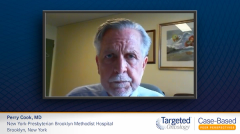
Treatment Selection for Later-Line Therapies in Follicular Lymphoma
Dr Perry Cook discusses the challenges of treating relapsed/refractory follicular lymphoma in later lines and describes ongoing developments in the treatment landscape.
Episodes in this series

Perry Cook, MD: How are patients treated who’ve had multiple lines of therapy? In the tazemetostat registration trial, some patients had had as many as 8 lines of therapy, as I recall. In my practice right now, there are multiple patients who are receiving their fourth and fifth lines of therapy. Some of them are receiving tazemetostat in these late lines of therapy. The considerations for patients in later lines of therapy are very much the same as for patients in earlier lines, what therapies are available, and what therapies can they tolerate. In my experience, the intravenous PI3 kinase inhibitor is tolerable for most patients. This patient had brittle diabetes and hypertension. Those are 2 [adverse] effects of that class of drug, both exacerbation of hyperglycemia and exacerbation of hypertension. Those would be relative contraindications to an elderly patient with brittle diabetes and hypertension. That would not apply to tazemetostat. Tazemetostat doesn’t perturb blood pressure and doesn’t perturb hyperglycemia, so it’s devoid of those [adverse] effects. It’s also well tolerated in patients who have limited marrow function, so patients who might have had 2 rounds of bendamustine and have baseline cytopenias because of marrow toxicity from prior lines of therapy. This is not prohibited in terms of the use of tazemetostat. It might be easier for these patients, for example, to tolerate tazemetostat than other marrow toxic drugs; IMiDs [immunomodulatory imide drugs] come to mind. That might be difficult in terms of blood count tolerance, given in a later line of heavily treated follicular lymphoma. These are things that have to be factored in as we select therapies.
How do I see the future for patients with follicular lymphoma? The recent past is very exciting, that we see the activity that is achievable with the PI3 kinase class of drugs, with the IMiDs, and finally with EZH2-directed drugs. We can anticipate a future in which CD19-directed therapies other than CAR T [chimeric antigen receptor T-cell therapy] may contribute to better outcomes for these patients. And we can readily anticipate there will be combinations of these new therapies that could be used together to achieve a better outcome. Beyond CD19 there are additional targets, either conjugated antibodies, or BiTE [bispecific T-cell engager] antibodies directed at CD20, CD19 that we can expect to change the future for patients with follicular lymphoma. I think it’s a very dynamic area, both in terms of the additions of new agents and the combination of existing agents, that we can expect to provide better outcomes for patients in the future.
This transcript has been edited for clarity.
Case: A 76-Year-Old Man With Relapsed/Refractory Follicular Lymphoma
Initial presentation
- A 76-year-old man complains of a 4-month history of bloating, fevers, and unintended weight loss of 9 lbs
- PMH: Medically-controlled hypertension, brittle diabetes, CABG 10 years prior
- SH: Lives by himself 2.5 hours from the clinic; only daughter lives out of state
- PE: palpable right axillary lymph nodes, ~ 3 cm and bilateral cervical lymph nodes, ~ 2 cm; spleen palpable 4.5 cm below left costal margin
Clinical workup
- Labs: ANC 1.6 x 109/L, WBC 11.4 x 109/L, 45% lymphocytes, Hb 9.5 g/dL, plt 96 x 109/L, LDH 426 U/L, B2M 3.4 µg/mL; HBV negative
- GFR 59 ml/min
- Excisional biopsy of the axillary lymph node on IHC showed CD 20+, CD 3+, CD5+, CD 10+, BCL2+; follicular lymphoma grade 2
- Bone marrow biopsy showed paratrabecular lymphoid aggregates, 42% involvement
- Cytogenetics: t(14;18) (q32;q21)
- Molecular testing: EZH2 wild type
- PET/CT showed right axillary, bilateral cervical, and mediastinal lymphadenopathy (3.3 cm, 3.4, cm and 2.6 cm, and 3.2 respectively)
- Ann Arbor Stage IV; ECOG 1
Treatment
- He was treated with bendamustine and rituximab for 6 cycles, achieved complete response and continued on rituximab maintenance
- Side effects included grade 3 diarrhea with BR
- 16 months later he complained of fevers and chills with increasing frequency
- Repeat PET/CT revealed progression of disease
- He received R-CHOP for 6 cycles and continued on rituximab maintenance
- 11 months later he had worsening fatigue and increased weight loss and work up revealed progressive disease
- He was started on tazemetostat 800 mg BID








































